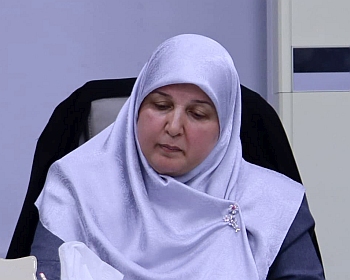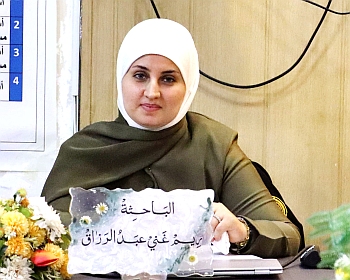ناقش قسم الفيزياء في كلية التربية للعلوم الصرفة (ابن الهيثم) اطروحة الدكتوراه ( التركيب النووي ونقاط القوة في جامو- تيلر لبعض النوى في القشر sd و fp بأستعمال أنموذج القشرة ) للطالبة ( سارة مهدي عبيد ) التي انجزتها تحت اشراف التدريسية في القسم ( أ.م.د. هدى مجيد توفيق ) ونوقشت من قبل اعضاء لجنة المناقشة المبينة اسمائهم فيما يأتي :
-
أ.د. رعد حميد مجيد (رئيسا).
-
أ.د.محمود سالم كريم (عضوا).
-
أ.د.فؤاد عطية مجيد ( عضوا).
-
أ.م.د. مصطفى كامل جاسم ( عضوا).
-
أحمد موسى أشويخ ( عضوا).
-
أ.م.د. هدى مجيد توفيق (عضوا و مشرفا).

تهدف هذه الدراسة إلى التعرف على التركيب النووي لبعض النظائر المختارة في منطقتي sd- و fp-shell من خلال الاستفادة من أحدث حسابات نموذج القشرة واسعة النطاق باستخدام الكود المحدثNushellX @ MSU لحساب مستويات طاقة التهيج ، أحتمالية رباعي الأنتقال الكهربائي المختزلة B (E2) ، وأحتمالات الانتقال المغناطيسي المختزلة B (M1) ونقاط قوة كامو -تيلرGamow-Teller B (GT) . سيتم تنفيذ حسابات أنموذج القشرة باستخدام التفاعلات المؤثرة USDA و USDB في نموذج الفضاء SD و FPD6 ، KB3G ، GXFP1A لفضاء الأنموذج FP . سيتم تنفيذ حسابات أنموذج القشرة بدون أي قيود مفروضة على فضاء الأنموذج. وسنقارن النتائج النظرية مستويات طاقة التهيج ، أحتمالية رباعي الأنتقال الكهربائي المختزلة B (E2) ،وأحتمالات الانتقال المغناطيسي المختزلة B (M1) ونقاط قوة كامو -تيلرGamow-Teller B (GT) مع البيانات التجريبية ذات الصلة المتاحة.
تم أجراء حسابات أنموذج القشرة على أساس مساحة أنموذج غير مقيد وبنطاق واسع لدراسة مستويات الطاقة المنخفضة وأحتماليات الأنتقال الكهربائية B(E2) والمغناطيسية B(M1) المختزلة ونقاط قوة كامو-تيلر B(GT) للأنتقالات (24Mg®24Na, 24Mg®24Al, 24Si®24Al) و (25Mg® 25Na, 25Mg®25Al, 25Si®25Al) و (26Mg®26Na, 26Mg®26Al, 26Si®26Al) التي تقع في منطقة القشرة sd و (42Ca®42Sc, 42Sc®42Ti) و (45Sc®45Ca, 45Ti®45Sc, 45V®45Ti) التي تقع في منطقة القشرة fp. أجربت الحسابات بأخذ القلب المغلق 16O للقشرة sd و 40Ca للقشرة fp بدون أي قيود مفروضة على النيوكليونات المكافئة خارج القلوب المغلقة.
أجريت حسابات أنموذج القشرة بأستعمال الأصدار الأخير لبرنامج أنموذج القشرة النووي NushellX@MSU عن طريق توظيف التفاعلات المؤثرة USDA و USDB للقشرة sd و GXFP1A و KB3G و FPD6 للقشرة fp .
قورنت حسابات مستويات الطاقة المنخفضة وأحتماليات الأنتقال الكهربائية B(E2) والمغناطيسية B(M1) المختزلة ونقاط قوة كامو-تيلر B(GT) مع البيانات التجريبية المقابلة لها. أُنتجت مستويات الطاقة المنخفضة بشكل مقبول للنويات المدروسة في كلا المنطقتين. تم تأكيد زخم وتماثل مستويات الطاقة الغير مؤكدة عمليا لبعض النويات التي تمت دراستها.
أن المقارنة بين الحسابات النظرية لأحتماليات الأنتقال الكهربائية B(E2) والمغناطيسية B(M1) المختزلة مع البيانات التجريبية أظهرت بشكل واضح أن تنبؤات أنموذج القشرة للأنتقالات بنفس الحزمة متوافقة مع البيانات التجريبية في القشرة sd وللأنتقالات بين حزم مختلفة فأن تنبؤات أنموذج القشرة لــــــ B(E2) و B(M1) كانت بتفاوت كبير مع البيانات التجريبية،أما بالنسبة للقشرة fp فأن تنبؤات أنموذج القشرة فيها تباين كبير مقارنة مع البيانات التجريبية.
كانت حسابات نقاط قوة كامو-تيلر B(GT) للنظائر المختارة والتي تقع في مناطق القشرتين sd و fp متوافقة بشكل كبير مع التفاعلات (3He,t) و *(3He,t) و (t, 3He) و (t, 3He+g) و (d, 2He) و (e–, ne) و ( p,n) المقاسة عمليا . النتائج جيدة نسبيًا لتوزيعات GT التجريبية وللقوى الانتقالية المجمعة B (GT). لقد توصلنا إلى اتفاق نوعي حول كل عملية انتقال بينما ترتبط نقاط القوة التراكمية المقاسة بشكل وثيق مع تلك التي لوحظت.
بعد اجراء الدراسة توصلنا الى التوصيات التالية :
-
يمكن توسعة هذا العمل لدراسة نظائر اخرى في المنطقتين sd و fp لتقييم نجاح أو قصور في حسابات أنموذج القشرة الحالية.
-
أستعمال جهود مختلفة لاجراء حسابات B(E2) و B(M1) بدلا من جهد المذبذب التوافي (HO) المستخدم حاليا، مث وود-ساكسون و سكيرم ..ألخ.
-
دراسة التركيب النووي للنوى أبعد من القشرة fp مثل المناطق 100Sn و 132Sn و 208Pb .
Department: Physics
Title of thesis: Nuclear Structure and Gamow-Teller Strengths of some Nuclei in the sd- and fp-Shells using Shell Model
Name: Sarah Mahdi Obaid Al-Shareefi
Supervisor
Asst.Prof.Dr. Huda Majeed Tawfeek
Aim of the Study: The present study aimed to investigate the nuclear structure of some selected isotopes lies in the sd- and fp-shell regions by utilizing the recent large scale shell model calculations using the updated code NushellX@MSU to calculate the excitation energy levels, reduced electric B(E2), reduced magnetic B(M1) transition probabilities and Gamow-Teller B(GT) strengths. Shell model calculations will be carried out using the effective USDB and USDA interactions in the model space SD, and the effective FPD6, KB3G, and GXFP1A interactions for the FP model space. The shell model calculation will be performed without any restriction imposed on the model space. The theoretical results for energy levels, reduced electric B(E2) and magnetic B(M1) transition probabilities and Gamow-Teller strengths B(GT) are to be compared with the relevant experimental data available.
Abstract: In the present study, the calculations of the shell model based on large-scale unrestricted model space has been conducted to study the energy levels of low-lying states, reduced electric B(E2) and magnetic B(M1) transition probabilities and Gamow-Teller B(GT) transition strengths for the transitions (Mg Na, MgAl, SiAl), (Mg Na, Mg Al, Si Al), (MgNa, MgAl, SiAl) lies in the -shell region and (CaSc, ScTi), (ScCa, TiSc, VTi) lies in the -shell region. The calculations have been performed by taken the core at O for -shell and Ca for -shell without any constraint put on the nucleons off the core.
The shell model calculation were performed using the recent version of the nuclear shell model code NushellX@MSU by employing the interactions USDB and USDA for the -shell and GXFP1A, KB3G and FPD6 for the -shell.
The calculations of the yrast levels, reduced electric B(E2) and reduced magnetic B(M1) transition probabilities and Gamow-Teller B(GT) transition strengths were compared with the corresponding experimental data. The low-lying energy levels were reasonably reproduced for the studied nuclei in both regions. The spin and parity of the unconfirmed energy levels for some of the studied nuclei have been confirmed.
The comparison between theoretical calculations of the reduced electric B(E2) and reduced magnetic B(M1) transition probabilities with the corresponding experimental data shows very clearly that the intraband transitions predicted by the shell model agrees very well with the experimental data for -shell and for the interband transitions the shell model predictions for B(E2) and B(M1) have big discrepancy compared with the experimental data, while for the -shell the shell model predictions have big discrepancy compared with the experimental data.
The calculation of Gamow-Teller (GT) transition strengths B(GT) for the selected isotopes lies in the – and -shell regions agrees very well with the measured (He,t), (He,t) , (t, He), (t, He+), (d, He), (, ) and (p,n) reactions. The results are relatively good for the measured GT values and for the summed transitional strengths B(GT). We have come to a qualitative agreement on each transition while the measured strengths of the cumulative transitions are closely correlated with those observed.
Future work
We recommend the following:
-
This work can be expended to study more isotopes lies in both and -shell regions to assets the success or shortfall of the present shell model calculations.
-
Using different potentials for the calculations of B(ME2) and B(M1) than the one used in our present calculations which is the harmonic oscillator (HO), like Woods-Saxon potential, Skyrme potential etc.
-
Subduing the nuclear structure for nuclei far from -shell like the , and










